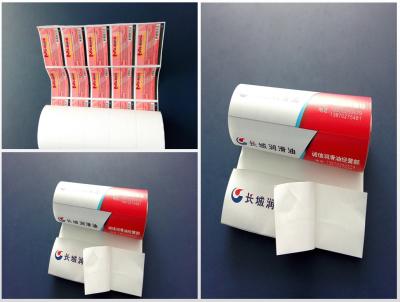Biodegradable Tear Resistant Stone Paper Label Adhensive Sticker For Wine Bevarage Bottle Forzen Food Packaging Label
Stone paper is Eco-friendly and a completely non-toxic, biodegradable alternative to paper. It is suited for many types of printing including offset lithography and screen print. True to the name, Stone paper consists mostly of calcium carbonate, a substance found in rocks and is completely tree-free. The paper will degrade safely, without the exhaustion of harmful gasses, and be completely gone in 9 to 12 months if left in nature. It can also be easily burned without the release of harmful gasses.
No trees, water, toxins or bleach are used in the production of Stone paper. Unused or excess Stone paper can be easily recycled into new Stone paper. Because it is tree free, and as a result fibre-free, it doesn’t absorb ink like traditional wood pulp paper and therefore uses 15 to 20% less ink during print in comparison to wood pulp paper. This results in an extremely sharp and crisp image.
Specification
| Shape: | Round, Square, Rectangular, Customized |
| Size: | Customized |
| Color: | Customized |
| Glue: | Removable, Strong, Reusable, Permanent |
| Material: | Fragile, Coated, Synthetic, PET, PP, PVC, Epoxy, Vinly, Gold Foil |
| Printing: | CMYK, Full-rotation, Silk-screen, Intermittent, Trademark, Laser coding, Die Cut, Holographic, Digital, Letterpress, Gravure, Flexography, Offset, IML, RFID, Spot-colour, Gold Stamping |
| Feature: | Water-proof, Scratch-proof, Weather-proof, Ultraviolet-proof, Eco-friendly |

Benefits for the environment
Comparisons have been made between products made from stone paper and traditional paper for applications such as book printing in Europe.
If the paper products were to replace coated and uncoated graphic paper in Europe, CO2 generation could be reduced by 62%, water consumption by 99.2% and wood use by 100%.
These results depend, however, on the type of calcium carbonate used for stone paper products and the origin of the HDPE.
The proportion of oil needed to make virgin HDPE for stone paper products is such that large-scale substitution of traditional paper could save 46% of the oil consumption of the current European graphic paper supply with virgin and recycled components.

Like any type of paper, it has a number of advantages and disadvantages due to its characteristics
Advantages
- It is water and tear resistant.
- This paper has no grain direction, making it incredibly smooth compared to normal paper.
- It is less environmentally damaging, as the CO2 is neutralised by the trees. By cutting down trees to make paper, the earth is less able to handle CO2 emissions, which play a major role in climate change.
- The paper is easy to recycle because it is photodegradable. It dissolves over time when exposed to sunlight.
Disadvantages
- It cannot be used to the same extent with printers because it is more sensitive to heat than normal paper.
- It degrades if left too long in the sun.
- It is more expensive to manufacture than normal paper and therefore more expensive for consumers and businesses to purchase.














